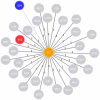Transmission of Escherichia coli Causing Pyometra between Two Female Dogs
- PMID: 36557718
- PMCID: PMC9781145
- DOI: 10.3390/microorganisms10122465
Transmission of Escherichia coli Causing Pyometra between Two Female Dogs
Abstract
Despite its clinical relevance, the pathogenesis of canine pyometra remains poorly understood. To date, it is recognized as a non-transmissible infectious disease. In this study, the simultaneous occurrence of pyometra and Escherichia coli in two cohabitant female dogs underwent in-depth investigation due to the hypothesis of transmission between these animals. Two 5-year-old Chow Chow dogs (namely, dogs 23 and 24-D23 and D24) were referred to a veterinary hospital with suspected pyometra. Both animals showed prostration, anorexia, and purulent vulvar discharge over a 1-week period. After ovariohysterectomy, uterine tissue, uterine contents, and rectal swabs were collected for histopathological and microbiological analysis. Uterine histology demonstrated purulent material and multifocal necrosis with endometrial ulceration, and a morphological diagnosis of pyometra was confirmed. Furthermore, E. coli from the same phylogroup (B2) and positive for the same virulence factors with the same antimicrobial susceptibility profile was isolated from the uterine contents of both dogs and the rectum of D23. Conversely, the E. coli strains recovered from D24 differed in phylogroup (one isolate), virulence factors (all three isolates), and antimicrobial susceptibility (all three isolates). Enterobacterial repetitive intergenic consensus polymerase chain reaction (ERIC-PCR) suggested that all isolates from the uterine content of both dogs and the rectal swab of D23 were 100% the same, but different from all isolates in the rectal swab of D24. One isolate from the uterine content of each animal as well as rectal swabs were subjected to whole-genome sequencing (WGS). Both whole-genome multilocus sequence typing(wgMLST) and single-nucleotide polymorphism (SNP) analysis supported the hypothesis that the isolates from the uterine content of both animals and the rectal swab of D23 were clonal. Taken together, these clinical features, pathology, microbiology, and molecular findings suggest, to the best of our knowledge, the first transmission of E. coli associated with pyometra between two animals. These results could impact the management of sites where several females cohabit in the same local area such as kennels.
Keywords: EnPEC; ExPEC; UPEC.
Conflict of interest statement
The authors declare no conflict of interest.
Figures




Similar articles
-
Canine Pyometra: A Short Review of Current Advances.Animals (Basel). 2023 Oct 25;13(21):3310. doi: 10.3390/ani13213310. Animals (Basel). 2023. PMID: 37958065 Free PMC article. Review.
-
Characterization of Escherichia coli in Dogs with Pyometra and the Influence of Diet on the Intestinal Colonization of Extraintestinal Pathogenic E. coli (ExPEC).Vet Sci. 2022 May 22;9(5):245. doi: 10.3390/vetsci9050245. Vet Sci. 2022. PMID: 35622773 Free PMC article.
-
Association between bacterial pathogenicity, endometrial histological changes and clinical prognosis in canine pyometra.Theriogenology. 2024 Jan 15;214:118-123. doi: 10.1016/j.theriogenology.2023.10.007. Epub 2023 Oct 17. Theriogenology. 2024. PMID: 37865019
-
Insights on the genetic features of endometrial pathogenic Escherichia coli strains from pyometra in companion animals: Improving the knowledge about pathogenesis.Infect Genet Evol. 2020 Nov;85:104453. doi: 10.1016/j.meegid.2020.104453. Epub 2020 Jul 7. Infect Genet Evol. 2020. PMID: 32649994
-
Escherichia coli isolated from pyometra and cystitis in the same animal exhibit a wide phenotypic similarity.J Appl Microbiol. 2024 May 1;135(5):lxae108. doi: 10.1093/jambio/lxae108. J Appl Microbiol. 2024. PMID: 38692849
Cited by
-
Canine Pyometra: A Short Review of Current Advances.Animals (Basel). 2023 Oct 25;13(21):3310. doi: 10.3390/ani13213310. Animals (Basel). 2023. PMID: 37958065 Free PMC article. Review.
References
-
- Jitpean S., Ström-Holst B., Emanuelson U., Höglund O.V., Pettersson A., Alneryd-Bull C., Hagman R. Outcome of Pyometra in Female Dogs and Predictors of Peritonitis and Prolonged Postoperative Hospitalization in Surgically Treated Cases. BMC Vet. Res. 2014;10:6. doi: 10.1186/1746-6148-10-6. - DOI - PMC - PubMed
-
- Müştak H.K., Günaydin E., Kaya İ.B., Salar M.Ö., Babacan O., Önat K., Ata Z., Diker K.S. Phylo-Typing of Clinical Escherichia coli Isolates Originating from Bovine Mastitis and Canine Pyometra and Urinary Tract Infection by Means of Quadruplex PCR. Vet. Q. 2015;35:194–199. doi: 10.1080/01652176.2015.1068963. - DOI - PubMed
Publication types
Grants and funding
LinkOut - more resources
Full Text Sources

